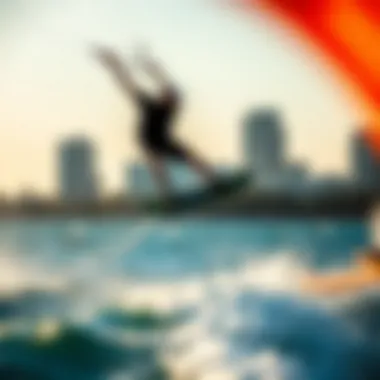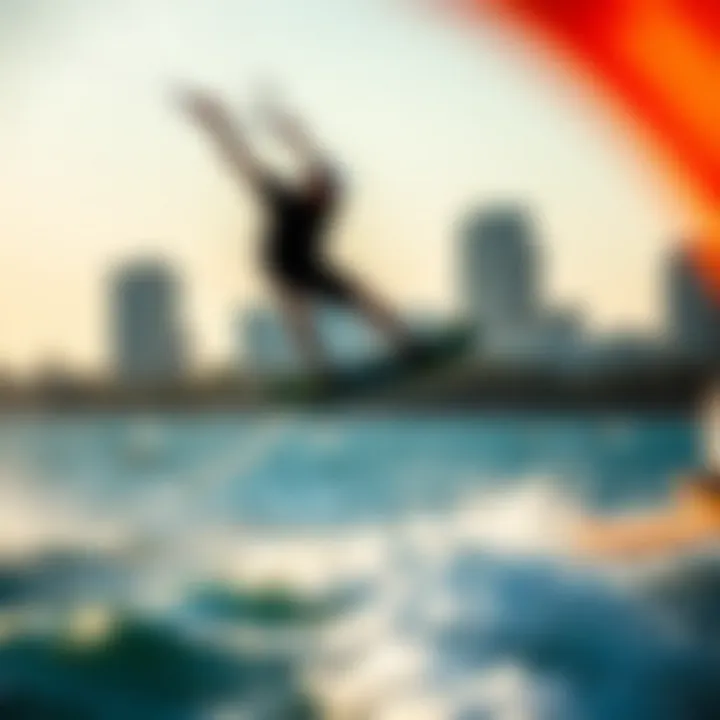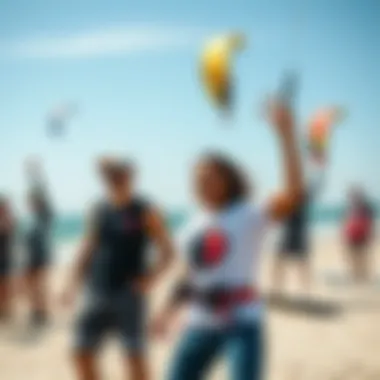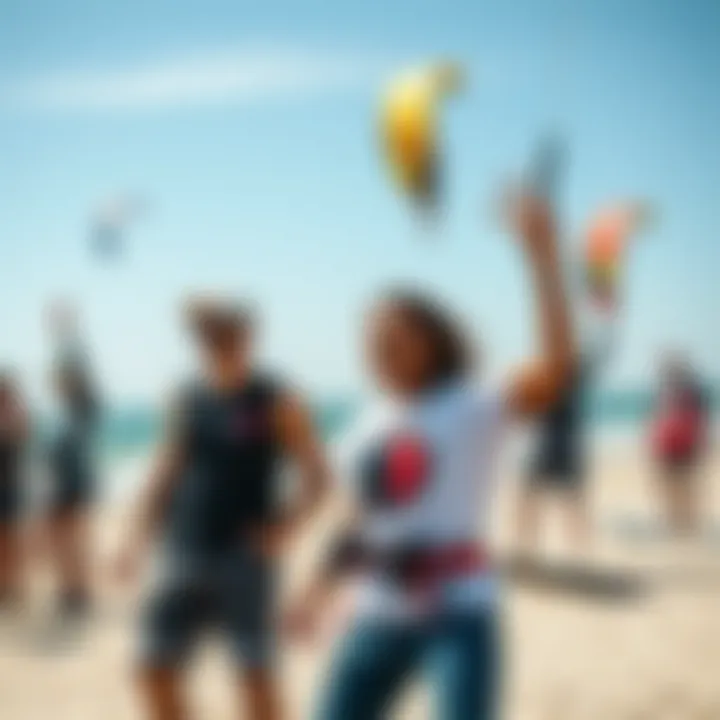Discover Kiteboarding in Dallas: A Complete Guide


Gear Selection
When diving into the world of kiteboarding, one might quickly realize that choosing the right gear is as crucial as mastering the techniques of the sport itself. Within Dallas, where the wind patterns can surprise both beginners and seasoned riders, having the proper equipment can make all the difference in achieving a thrilling experience.
Types of Kites
Kiteboarding kites are the heart of the sport, designed with specific wind conditions and skill levels in mind. Broadly speaking, they are categorized into two main types: C-kites and bow kites.
- C-kites have a more traditional shape and are favored for their explosive power and performance in tricks. They tend to excel in high winds and are popular among experienced riders.
- On the other hand, bow kites offer versatility, designed with a flatter profile to generate more lift. This makes them easier to control, which can be enormously beneficial for those just starting their journey.
In addition, hybrid kites blend features from both styles, catering to a range of conditions. So, if you’re pondering which kite to pick up, consider the average wind conditions you’ll encounter on the water in Dallas, as well as your level of expertise.
Choosing the Right Board
Your board can impact your ride significantly, shaping techniques and maneuverability. Kiteboards typically come in two varieties: directional boards and twin-tip boards.
- Directional boards are designed for surfing and are typically used in more advanced maneuvers. They perform better in waves and are best suited for the experienced kiteboarder, especially in locations like Lake Grapevine where wave conditions can arise.
- Twin-tip boards, favored among many for their versatility, are symmetrical and can be ridden in either direction. They allow for a range of tricks and maneuvers, making them a popular choice for beginners and seasoned riders alike.
Aside from the type of board, considering factors like length and width is imperative as they affect speed and stability. A wider board can provide additional buoyancy, making for a smoother ride, especially in choppy waters.
Skill Development
As one embarks on their kiteboarding adventure, skill development is key. While it’s tempting to rush to tackle impressive stunts, focusing on essential techniques lays a solid foundation for a lifetime of enjoyment on the water.
Essential Techniques
One of the most fundamental skills every kiteboarder must master is how to control the kite properly. Being able to fly it efficiently involves practicing correct body positioning and understanding kite dynamics. A great starting point is to get the kite low in the power zone while maintaining an optimal angle of attack, which maximizes wind power and minimizes drag.
Moreover, learning to manage kite speed and responding effectively to changes in wind conditions is vital. Practicing relaunching the kite during your sessions builds the confidence needed for unpredictable scenarios. Starting in lighter winds can also ease the process, allowing for gradual skill enhancement.
Progression Tips
Once foundational skills are grasped, progression naturally follows. One tip involves pairing up with a more experienced rider or joining local kiteboarding communities. Building connections can provide invaluable support and insight, as they often share tips only seasoned kiteboarders know. Participating in local events or meetups can introduce fresh perspectives and inspire new techniques.
Additionally, documenting your rides can help in analyzing your growth. A simple video can highlight areas of improvement, making it easier to develop a personalized training approach.
"Kiteboarding is as much about the journey as it is the destination. Each wave, each gust of wind is a lesson waiting to unfold."
As kiteboarding in Dallas continues to evolve with local enthusiasts pushing its boundaries, staying equipped with the right gear and skills elevates both the enjoyment and safety of the experience. Through understanding and exploration, this thrilling water sport beckons adventure seekers to glide across the waves, armed with knowledge and camaraderie.
The Rise of Kiteboarding in Dallas
Kiteboarding has surged in popularity across the globe, and Dallas has become a hotspot for this exhilarating water sport. The rise of kiteboarding in this city merges the thrill of riding the wind with the unique characteristics of the local environment. Dallas, with its sprawling lakes and open spaces, presents an alluring backdrop for enthusiasts to embrace this adventurous activity. In this section, we delve into the historical context and current popularity of kiteboarding in Dallas, providing insights into how this sport has developed a dedicated following among both locals and visitors alike.
Historical Background
Kiteboarding is not a brand-new pastime; it has its roots in the early 1990s when adventurous souls first experimented with combining surfing and kite-flying. However, kiteboarding took some time to make its way to Dallas, a landlocked city not typically associated with surfing-type watersports. It wasn’t until the early 2000s that kiteboarding began to catch on in Dallas. More and more riders began to flock to the area's lakes, drawn by the promise of exhilarating wind and water conditions.
Local aficionados often recall specific events that contributed to this rise; kiteboarding schools popped up, offering lessons for eager learners. Word of mouth spread like wildfire, and before long, Dallas transformed into a kiteboarding destination for both beginners and seasoned kiteboarders. The community rallied around the sport, hosting informal meets and sharing tips, which gradually laid the groundwork for a vibrant kiteboarding culture.
Current Popularity
In recent years, kiteboarding has continued to gain traction within Dallas, transforming from a niche sport into a well-recognized activity. The growth can be attributed to several key factors:
- Favorable Wind Conditions: Dallas boasts unique meteorological patterns that create ideal kiteboarding conditions, especially during spring and fall. Enthusiasts know to seize the winds when they pick up, leading to busy weekends at local lakes.
- Community Engagement: The local scene has birthed numerous clubs and groups where kiteboarders can connect, share experiences, and learn from each other. This networking has fostered a sense of belonging among riders.
- Events and Competitions: The city's annual kiteboarding events and competitions have attracted attention from locals and visitors, serving as gatherings that promote the sport and inspire newcomers to try it.
As kiteboarding continues to ascend in popularity, it reflects not just the willingness of individuals to embrace adventure but also serves as a testament to the dynamic outdoor lifestyle that Dallas offers to its residents. With continuous improvements in gear and technique, this sport is likely to see even more growth in the coming years. It's clear that kiteboarding is here to stay, firmly rooting itself in the cultural fabric of Dallas.
Understanding the Equipment
Understanding the equipment is fundamental to kiteboarding, especially given the variety of gear available in the Dallas area. Having the right equipment can greatly enhance not only your performance but also your enjoyment of the sport. When selecting gear, a kiteboarder must consider multiple factors like personal skill level, wind conditions, and water type. This knowledge can prevent mishaps and ensure a safe, exhilarating experience on the water.
Kite Selection
Choosing the right kite might feel like hunting for a needle in a haystack at first. Kites come in different shapes, sizes, and materials, each designed for particular wind conditions and styles of riding. It could be easy to think all kites are created equal, but that's far from the truth.
For instance, when deciding on a kite, beginners often find inflatable kites to be a popular choice. They are more stable and offer better water relaunch abilities, which is a real game-changer when you're still grasping control. Transitioning to a more advanced kite, such as a C-kite, tends to be favored by experienced riders for their agility and responsiveness. Becoming acquainted with the various types of kites and their characteristics allows kiteboarders to select a model that genuinely fits their goals and comfort level. Just like that, one can elevate their kiteboarding game.
Board Types
When it comes to boards, there's no one-size-fits-all option. Riders have three primary styles to choose from, each with its unique advantages and disadvantages. Understanding how each type works can make a world of difference in performance and enjoyment.
Directional Boards


Directional boards cater to riders who favor a more surf-style approach. These boards are typically longer and narrower, offering smooth carving and the ability to ride upwind effectively. A key characteristic of directional boards is that they are designed to be ridden in one direction, resembling a surfboard more than a skateboard.
These boards excel at handling waves and offer exceptional stability in the water, which is essential for capturing those thrilling rides. However, they may prove tricky for beginners unfamiliar with their movement dynamics. The learning curve can be steep, but the reward is quite satisfying for those who master them.
Twintip Boards
Twintip boards are the Swiss Army knives of the kiteboarding world, suitable for both beginner and skilled riders. They can be ridden forwards or backward, making them highly versatile. A notable feature is their symmetrical shape, allowing riders to change directions seamlessly without needing to switch stance.
This dual functionality unlocks endless possibilities for tricks and maneuvers, which makes twintips a popular choice among many locals. However, they are generally not as effective for wave riding as directional boards, but they shine in flat water environments.
Foil Boards
Foil boards offer a unique twist in kiteboarding, literally lifting the rider above the water’s surface. With their hydrofoil construction, they reduce drag significantly, allowing for smooth cruising even in lighter winds. The sensation of gliding above water creates an exhilarating feeling that many enthusiasts adore.
However, this type of board requires some finesse and is often recommended for more experienced kiteboarders. While they can be a fantastic option for calm days, potential buyers should consider the learning curve associated with mastering foil riding skillfully.
Safety Gear Essentials
No matter the type of board or kite chosen, safety gear should never be an afterthought. Essential items include a helmet, impact vest, and a quick-release harness system. Wearing the right safety gear can make a substantial difference in preventing injuries, especially when one is learning. By prioritizing safety, kiteboarders can savor the thrill of the sport without putting themselves in harm's way.
That being said, investing in good quality gear not only enhances performance but also contributes to a safe and fantastic kiteboarding experience.
Best Locations for Kiteboarding in Dallas
When it comes to kiteboarding, selecting the right spot can make or break your experience. In Dallas, you have a treasure trove of options that cater to the diverse needs of kiteboarders. Each location offers unique features, wind conditions, and community vibes that can enrich your time on the water. Here, we explore some of the key sites for kiteboarding in the Dallas area, showcasing why they earn their stripes, or rather their kites, in the kiteboarding community.
Lakes and Waterways
Lake Lewisville
Lake Lewisville is often the hallmark of kiteboarding spots around Dallas. Its vast expanse of water provides ample room for kiteboarders to explore their limits. One of the outstanding traits of this lake is its consistent wind patterns, particularly during the spring months, which attract many kiteboarders. Notably, the lake features several designated areas that keep water sports separated from fishing and swimming zones, ensuring safety for everyone involved.
Key Feature: The well-defined areas for various water activities make Lake Lewisville a safe and enjoyable choice for kiteboarders.
Advantages: With its accessibility, kiteboarding classes frequently occur here, making it a community hub for enthusiasts eager to learn the ropes or hone their skills.
Disadvantages: The popular kiteboarding spots can get crowded, particularly on weekends, making it essential to get there early if you want to snag prime real estate on the water.
White Rock Lake
White Rock Lake offers a different flavor to the kiteboarding palate. Nestled in the heart of Dallas, this spot is perfect for those wanting a quick escape from the bustle of city life. The lake boasts crystal-clear waters surrounded by lush greenery, providing a picturesque backdrop that adds to the overall experience.
Key Characteristic: The scenic views and relatively calm waters make White Rock Lake a favored spot for beginners who are still finding their sea legs with kiteboarding.
Unique Feature: Its proximity to downtown means that locals can easily access it for a quick session after work—a solid win for the urban kiteboarder.
Advantages: There's a strong community feel around this lake, with many local clubs organizing meet-ups and informal competitions, fostering camaraderie among kiteboarders.
Disadvantages: Wind conditions can be unpredictable, which may limit the kiteboarding opportunities compared to other sites. It’s wise to check the forecast before heading out to improve your chances of a successful session.
Turtle Creek
For those seeking a more urban kiteboarding vibe, Turtle Creek provides a unique blend of city life and water sports. While it’s not as expansive as the other locations, kiteboarding here offers an urban twist, attracting those who like to mix their adrenaline with a view of Dallas's skyline.
Key Characteristic: Its tranquil waters are a surprising feature for kiteboarders who often expect wide, open spaces—yet it manages to provide a calming wind that is perfect for practiced kiteboarders.
Unique Feature: The combination of natural beauty and cityscape makes Turtle Creek an Instagram-worthy spot, providing stunning backdrops for those capturing their kiteboarding moments.
Advantages: The location is less crowded than the lakes, allowing for more focused practice and fewer interruptions.
Disadvantages: The size of the creek limits the space to maneuver, which can be a drawback for more advanced kiteboarders who require more area to truly let loose.
Popular Spots Among Locals
In addition to the aforementioned lakes, several hidden gems and local favorites exist throughout the Dallas area. These spots are often frequented by experienced kiteboarders looking to unwind or share their passion with newcomers. Communities form around these locations, offering a rich atmosphere of learning and sharing.
The importance of finding the right spot cannot be overstated. It not only influences the immediate experience of kiteboarding but also affects one's growth in the sport—right from initial learning stages to becoming a seasoned pro.
As the kiteboarding culture grows in Dallas, so do the opportunities to learn and engage. Joining local groups or forums can uncover even more spots tailored to your needs, ensuring that no one misses out on the joy of ride the wind.
Kiteboarding Events and Competitions
Kiteboarding is not just about the thrill of the ride; it’s also about community spirit, friendly rivalries, and the joy of sharing the water with fellow enthusiasts. Events and competitions play a critical role in fostering this community, boosting skills, and elevating interest in the sport across Dallas. Such gatherings offer kiteboarders a platform to showcase their talents, learn from each other, and form lasting connections. Additionally, they draw spectators, further enriching local culture and promoting the sport.
Local Kiteboarding Events


In Dallas, local kiteboarding events serve as the heartbeat of the kiteboarding community. These events are often held at popular lakes like Lake Lewisville or White Rock Lake, where the wind and water conditions are favorable. Each event typically includes a series of heats that allow participants to compete in various categories, from freestyle tricks to racing against the clock.
Events like the Dallas Kiteboarding Festival not only display skill but also emphasize safety, awareness, and environmental consciousness, allowing everyone involved to celebrate the sport's essence while respecting Mother Nature. Not to forget, these gatherings are the perfect opportunity for local businesses to showcase their products, from the latest gear to vegan snacks.
Events also feature:
- Workshops for beginners led by experienced instructors.
- Social meetups that allow kiteboarders to share tips and tricks.
- Family-friendly activities, ensuring everyone has a chance to participate, whether on the water or on the beach.
National and International Competitions
As kiteboarding gains traction, it has also garnered attention on a grander scale through national and international competitions. Events such as the Kiteboarding World Cup or the U.S. Kiteboarding Nationals attract top-tier athletes from around the globe. These competitions challenge participants at a higher level and offer significant prestige, as well as the chance to gain valuable sponsorships.
Dallas might be known for its local events, but it’s essential to keep an eye on major international ones. Attending these events not only inspires local kiteboarders but also presents the chance to witness world-class performances firsthand.
Key aspects of these competitions include:
- Diverse Skill Levels: Competitions cater to various skill sets, allowing novices to compete alongside professional athletes.
- Innovative Tricks: Watching athletes push their limits can inspire local kiteboarders to innovate and expand their own skills.
- Networking Opportunities: Tournaments often have industry leaders in attendance, providing chances for aspiring athletes to network.
The End
Kiteboarding events and competitions enrich the community by showcasing talent, fostering connections, and promoting the sport at large. Whether you are participating or just cheering from the sidelines, these gatherings are crucial in shaping the kiteboarding landscape in and around Dallas. The camaraderie and excitement grow each year, making attending these events a priority for any serious kiteboarder.
Safety Protocols and Best Practices
When stepping into the world of kiteboarding, safety should never take a back seat. This sport, while exhilarating, comes with its own set of risks. Implementing sound safety protocols and best practices not only protects kiteboarders but also contributes to a more enjoyable experience on the water for everyone involved. Given the unpredictable nature of water sports and the elements at play, understanding these protocols becomes paramount.
Understanding Wind Conditions
Wind is the lifeblood of kiteboarding. A kiteboarder’s performance largely depends on understanding the nuances of wind speeds and directions. Not all winds are created equal; a slight change in direction can dramatically alter the level of safety and enjoyment in your session. Here are some key points to keep in mind:
- Know Your Wind Speeds: Familiarize yourself with the Beaufort scale, which ranges from calm winds that barely ripple the water to strong winds ideal for advanced boarders. Beginners should aim for winds of 12 to 20 knots for the most manageable conditions.
- Wind Direction: It’s crucial to know how the wind interacts with the location you choose. Side-onshore winds are among the safest for beginners, while offshore winds can quickly lead to dangerous scenarios where a kiteboarder can drift into open water.
- Local Patterns: Every location has its own quirks. For instance, Lake Lewisville may experience thermals that can ramp up wind conditions in the afternoon. Keeping an eye on local weather patterns and consulting resources like Windfinder can offer timely updates.
Understanding these wind factors not only enhances your kiteboarding skills, but also minimizes risks associated with changes in weather.
Emergency Procedures
No matter how experienced a kiteboarder you are, understanding and preparing for emergencies is crucial. Kiteboarding can turn dicey in a flash, so being equipped with emergency procedures is non-negotiable:
- Self-Rescue Techniques: One of the first things every kiteboarder should learn is how to self-rescue. This involves knowing how to detach from the kite and use it as a flotation device. Make sure you practice this in safer conditions before heading out for the day.
- Teamwork: Kiteboarding often attracts a community of fellow riders. In case of emergency, a buddy system is invaluable. Always check in with fellow kiteboarders before heading out and be ready to assist each other if the situation arises.
- Know the Signals: If you’re in distress, clear and recognizable signals are vital. A simple raised arm can attract attention. Don’t underestimate the power of signaling, as it can be the difference between a quick rescue and a longer wait.
- Emergency Contacts: Keep emergency numbers handy, including local rescue services and personal contacts. Familiarize yourself with local safety protocols posted at kiteboarding locations.
Incorporating these emergency procedures into your routine ensures that you and those around you remain safe while partaking in this adventurous sport.
Important Note: Always have a personal flotation device (PFD) on hand, and consider wearing one at all times. It adds an extra layer of safety, especially in case of unexpected mishaps.
With a comprehensive understanding of wind conditions and a set plan for emergencies, kiteboarders can tackle the sport with not only skill but also peace of mind. The wave of adventure awaits, but let safety lead the way.
Environmental Considerations
Understanding environmental considerations is key for kiteboarding enthusiasts in Dallas. The natural surroundings not only influence the kiteboarding experience but also dictate the future of the sport. Appreciating these factors helps in maintaining a balance between enjoying this water sport and protecting our ecosystems.
Impact of Kiteboarding on Local Ecosystems
As kiteboarding gains popularity in Dallas, it’s essential to address its impact on local ecosystems. Disturbances can occur, especially in sensitive areas where wildlife habitats exist. Kiteboarders frequently practice close to shorelines, which can unintentionally disrupt nesting birds or other aquatic creatures.
"Hitting the waves shouldn't mean hitting the brakes on nature. Being mindful of our surroundings guards both our sport and the environment."
To ensure minimal disruption:
- Stay away from sensitive areas: Avoid regions known for bird nesting or wildlife refuges, especially during breeding seasons.
- Respect local regulations: Many parks and waterways have specific rules regarding access and behavior, which helps in protecting wildlife.
- Observe natural buffers: Keeping a safe distance from plant life or rocky shores is vital. This reduces erosion and other potential damage to the land.
Kiteboarding can lead to sediment disturbance, which affects water quality and marine life. Educating participants about these aspects can encourage more responsible practices.
Sustainable Practices for Kiteboarders
To preserve the beauty and integrity of natural environments, kiteboarders must adopt sustainable practices. These not only enhance the experience but also ensure that the sport can be enjoyed for years to come. A few actionable steps include:
- Proper Equipment Maintenance: Regularly check and maintain gear to reduce environmental impact. Broken or discarded equipment can become marine debris.
- Choose Eco-Friendly Gear: Many manufacturers are now producing biodegradable or environmentally safe gear. Opting for these products can lessen the ecological footprint.
- Participate in Clean-Up Events: Joining local clean-up initiatives can be an excellent way to give back to the community while enjoying the sport. Not only does it help the environment, but it also fosters camaraderie among kiteboarders.
- Raise Awareness: Share knowledge with fellow kiteboarders about best practices. Simple conversations can go a long way in spreading the message about sustainability.
Engaging with the environment responsibly fosters goodwill in the kiteboarding community and helps ensure the sport continues to thrive amid growing concerns over climate change and habitat destruction. As the saying goes, what goes around comes around; let's make sure we're giving back as much as we're taking.
Training and Tutorials
When it comes to mastering kiteboarding, the learning curve can be as steep as the wind-whipped waves. This section is key because having proper training and tutorials can mean the difference between a thrilling ride and a head-first plunge into the water. Knowledge about techniques, equipment handling, and safety measures enhances the overall experience. Whether you're a newcomer or a seasoned rider looking to sharpen your skills, tapping into the right educational resources is essential.
Finding Instructors in Dallas


In Dallas, finding a qualified instructor is crucial for those who wish to quicken their journey into kiteboarding. Several local schools offer structured lessons tailored to a variety of skill levels. You not only get to learn from experienced kiteboarders, but also you build confidence as you get familiar with the equipment and the water conditions.
Here are a few places to consider:
- Dallas Kiteboarding School: Known for its personalized attention and comprehensive courses, this school provides both group and private lessons.
- Kiteboarding Dallas Academy: This academy focuses on having fun while learning, incorporating safety practices throughout the sessions.”
- Local Meetups: Engaging with kiteboarding clubs can help you connect with instructors who might not advertise their services extensively.
Self-Learning Resources
While having an instructor can indeed accelerate your learning, some kiteboarders prefer the self-taught route, using diverse resources to gain knowledge at their own pace.
Online Courses
Taking online courses can be a game changer. These courses often combine video demonstrations with written material that allows learners to digest information at their own rhythm. Key characteristics include:
- Flexibility: You can learn whenever and wherever the wind takes you.
- Wide Variety of Topics: From basic principles to advanced maneuvers, you can find courses covering nearly every aspect of kiteboarding.
For example, Kiteboarding.com has a variety of lessons available, making it easy to select what fits your needs. However, one must note that:
- Self-Motivation is Important: Without a live instructor, you need to manage your progress and stay focused.
Local Workshops
Local workshops offer a fantastic alternative to online learning. These workshops typically involve hands-on training, which can enrich the learning experience significantly. They usually cover essential skills in a few hours to a couple of days. Highlighting characteristics:
- In-Person Guidance: Having a trainer right beside you can help correct mistakes in real-time.
- Networking Opportunities: Meeting other enthusiasts and instructors during these workshops can create lasting camaraderie.
One popular venue is the Dallas Watersports center, where they host workshops catered to different skill levels regularly. While engaging in local workshops presents an advantage, it's also worth noting:
- Cost: Typically, in-person workshops may require a higher investment compared to online alternatives, but the value of direct interaction can justify the price.
"Even the most experienced rider acknowledges that there’s always something new to learn. Continuous education, whether through self-start courses or local workshops, enhances what's already a thrilling sport.”
In summary, whether you prefer structured lessons or self-guided sessions, the resources available in Dallas provide ample opportunities for kiteboarding enthusiasts to expand their skills. Wherever you find yourself in this skill curve, dive deep into the world of kiteboarding knowledge and let the waves carry you forward.
Community and Networking
Building a vibrant community around kiteboarding in Dallas is essential to the sport's growth and sustainability. More than just a leisure activity, kiteboarding fosters connections among enthusiasts who share the same passion for this thrilling water sport. Networking within the kiteboarding community can often lead to lasting friendships, partnerships for tackling the waves together, and access to valuable insights that can enhance one's skillset.
In the realm of kiteboarding, connections often translate to shared experiences, knowledge, and the opportunity to participate in local events. These interactions enrich the kiteboarding culture and amplify the enjoyment of the sport. For many, kiteboarding is more than an individual endeavor; it's a way to connect with others who understand that electrifying rush when the kite catches the wind.
Local Kiteboarding Clubs
In Dallas, participation in local kiteboarding clubs can offer kiteboarders a structured way to engage with their peers. These clubs often organize regular outings, training sessions, and social gatherings. Members benefit from the collective experience of fellow kiteboarders, a feature that can be particularly advantageous for newcomers.
Joining a local club can help in several ways:
- Access to Resources: Clubs typically provide shared equipment, lessons, or instructional workshops aimed at improving skills.
- Group Safety: Kiteboarding in a community setting enhances safety, as members can keep an eye out for each other while enjoying the sport.
- Networking Opportunities: Clubs often host events, competitions, and social gatherings where members can meet potential friends or mentors.
Popular clubs around the Dallas region that kiteboarders should consider joining include the Dallas Kiteboarding Association. This club is a great starting point for anyone looking to immerse themselves in the local kiteboarding scene. More details can usually be found on their Facebook page.
Social Media and Online Forums
In today’s digitally connected world, social media platforms and online forums have become essential tools for kiteboarders looking to connect. These spaces allow individuals not only to share their experiences but also to seek advice, discuss trends, and keep up with local and national events. The use of platforms like Reddit and Facebook can provide immediate access to a wealth of information in the kiteboarding community.
Consider the following benefits:
- Real-Time Updates: Social media keeps enthusiasts informed about weather conditions, meet-ups, and community initiatives.
- Shared Knowledge: Forums provide a space for individuals to ask questions, share tips, and broadcast success stories that others can learn from.
- Event Promotion: Clubs and organizations advertise events, competitions, and trainings on these platforms, making it easier for participants to engage.
For instance, on the Kiteboarding subreddit, one can find discussions ranging from equipment reviews to trip recommendations, catering not only to local matters but also to global kiteboarding topics.
Joining the kiteboarding community – both in-person and online – can transform your experience in ways you never imagined, paving the way for new friendships and exhilarating moments on the water.
Community and networking are fundamental to the kiteboarding experience in Dallas. By engaging with local clubs and using social media, enthusiasts can enhance their skills, safety, and enjoyment of the sport.
The Future of Kiteboarding in Dallas
The kiteboarding scene in Dallas is poised for exciting developments in the years ahead. As the sport grows in popularity, it reflects broader trends in outdoor sports and adventure activities. The evolution of kiteboarding here is not just about expanding a pastime; it dives deeper into the cultural fabric of the local area.
Emerging Trends
In this vibrant city, several noteworthy trends are emerging that can potentially reshape the kiteboarding landscape:
- Technological Advancements: With innovations like better kite materials and intelligent design, equipment is becoming more accessible and enjoyable for beginners. The rise of lightweight, durable kites means that even on calmer days, enthusiasts can still catch some air.
- Diversity of Kiteboarding Styles: People are starting to branch out from traditional kiteboarding to various styles like freestyle or wave riding. This diversity introduces different communities within the sport, creating opportunities for collaboration and sharing techniques.
- Expanded Training Programs: As more schools and instructors emerge in Dallas, the number of organized courses is growing. This influx offers tailored programs for all skill levels, encouraging more people to delve into kiteboarding. Further, many instructors integrate community focus, fostering asense of camaraderie among participants.
- Environmental Awareness: Sustainability is becoming increasingly important. Kiteboarders are advocating for the protection of natural spaces. This push means the future may see regulations that balance recreation with conservation. Community members are already engaging in clean-ups and awareness programs about their local environments, reflecting all around change in attitude.
"The growth of kiteboarding in Dallas isn’t just a personal journey; it’s about building a community that values our environment and supports newcomers to the sport."
Potential Challenges
However, as with every evolving sport, challenges and hurdles dot the horizon of kiteboarding in Dallas:
- Infrastructure Limitations: Not all prime locations have the necessary facilities. Accessibility to water and safety infrastructure like proper launch and landing zones can be lacking. This limitation can frustrate both seasoned riders and newcomers who wish to join in the fun.
- Environmental Restrictions: With the rise in beach and lake use, regulatory measures may be put in place that could restrict where and when kiteboarding can occur. These can pose challenges as people seek to balance ecological preservation with recreational pursuits.
- Market Saturation: As the sport gains momentum, the influx of new instructors and rental shops may lead to competition that forces some businesses to shut their doors. This could potentially lead to fewer options and diminished quality in services.
- Skill Gap: As kiteboarding evolves, the gap between novice and expert riders may widen. If experienced kiteboarders invest time in refining their techniques, newcomers may feel overwhelmed, potentially discouraging them.
The trajectory for kiteboarding in Dallas is filled with potential, but it requires both commitment and foresight from its community. If the local kiteboarders can embrace change and navigate the challenges ahead, the future of this exhilarating sport can be incredibly bright.















